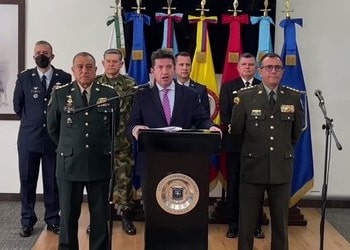The death of one of the last remaining leaders of the ex-FARC Mafia leaves one of Colombia’s major criminal structures without any clear unifying force and may signal the disintegration of the dissidents in Colombia.
On July 15, Colombian Defense Minister Diego Molano confirmed the death of Néstor Gregorio Vera, alias “Iván Mordisco,” the head of the Western Coordinating Command (Comando Coordinador de Occidente – CCO) and commander of the 1st and 7th Fronts of the ex–FARC Mafia.
During a press conference, Molano stated that Mordisco had been killed in a joint operation conducted by the police and the Army in the southern department of Caquetá. General Luis Fernando Navarro Jiménez, commander of Colombia’s Armed Forces, said that “intelligence confirmed that the outlaw died there [Caquetá].” Nine other dissidents were also reportedly killed in the operation.
SEE ALSO: Failed Kingpin Strategy at Heart of New US-Mexico Security Plans
Mordisco led the CCO, a federation of former FARC dissidents present mainly in southern Colombia and the Pacific Coast, and along the country’s border with Venezuela. He commanded the 1st and 7th Fronts, which opposed the 2016 peace agreement signed between the Colombian government and the now-defunct Revolutionary Armed Forces of Colombia (Fuerzas Armadas Revolucionarias de Colombia – FARC).
Following the death of the former commander of the dissident factions, Miguel Botache Santillana, alias “Gentil Duarte,” in May 2022, Iván Mordisco assumed the responsibility of maintaining the alliance.
Now that both commanders have perished, the dissidents under the CCO are left without a natural successor.
InSight Crime Analysis
The death of Iván Mordisco is likely the final blow to any fading aspirations of reuniting the ex-FARC Mafia into a single criminal force. Major dissident factions have lost at least seven top commanders at the hands of Colombian forces and rival factions since the start of 2021.
Mordisco was the first senior FARC commander to oppose the peace agreement with the government. He lambasted other FARC leaders as traitors for agreeing to lay down their arms. Over time, he and Duarte would forge the CCO, the strongest faction of the ex-FARC Mafia. For a time, it seemed they had a credible chance of reuniting a large portion of this loosely connected network of dissidents.
SEE ALSO: Gentil Duarte’s Master Plan to Reunite Colombia’s FARC Dissidents
After Duarte’s death, Mordisco was the most logical choice to be the figurehead for the ex-FARC Mafia. But nothing ever came of his short time in overall command as he would be killed just three months later.
Had he lived, it is unlikely that he would have been able to maintain cohesion within the CCO without his greatest ally, Gentil Duarte. Mordisco did not have the same level of experience within the FARC, nor did he come backed by the same ideological credentials.
Despite these reservations, his death leaves a gaping void in the ranks of the ex-FARC Mafia. The CCO federation may now struggle to stay together as no commander appears poised to take over. As a result, these dissident factions may be pushed further apart, worsening the fragmentation and violence in Colombia’s criminal landscape.

